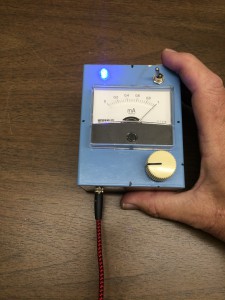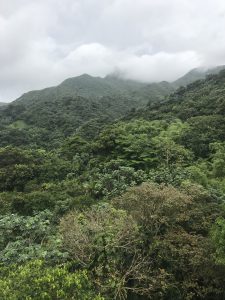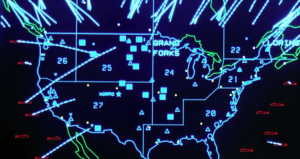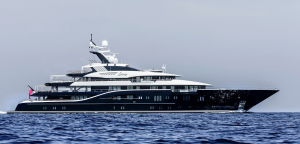Realities of Sailboats
Docked at One of the Larger Slips at The Yacht Club Marina
I haven’t posted a sailing blog in a while because we have been waiting here in Palmas to get some boat maintenance done. The maintenance is finally complete and it took a while. I’ll describe below what we had to do and the events leading up to our extended stay here. BTW, we are not suffering!
So what happened: A few weeks ago we had gotten some routine maintenance done on the engine and generator, an oil change basically. We had been waiting to get the service done (nothing happens quickly here, island time you know) so that we could head out for a couple of weeks around Vieques and Culebra islands. We exited the marina and were about 3 miles out when the engine started sounding funny, like it was going to quit. We needed the engine to go east into the wind and waves. After the third engine hiccup, Shelly declared we were turning back. We got pointed back toward the marina and the engine quit. No matter what we did it would not start. I noticed the Racor filter bulb was not full indicating that there was no fuel coming in from the tank.
I could not think of a way to get the fuel flowing again so we put the sails up. We had an excellent east wind that let us sail straight back to the marina entrance. But we still had a problem, we had no way to maneuver in the tight spaces of the marina, or stop, once we got there. And the entrance was tricky, it was somewhat narrow with rocks on both sides, and some decent waves to push you around as you came in.
Shelly called for a tow. This is quite simple back in the states and all up and down the east coast there are boat towing companies. Here, not so much. They do exist, but it turns out they were all working at the site of a plane crash that had happened not too far away the day before. What are the chances?
Shelly called the marina. They said they could help us get in but we’d have to get through the breakwater entrance first. As we approached, we dropped our main and reefed the jib way, way back so that we would slow down but maintain steering. We passed the rocks outside the entrance, they were alarmingly close. The boat, however, handled excellently and we sailed right up to the long outside dock of the marina, and we were going slowly enough that they could stop us with our dock lines. They did come out to help in their small boat but I think events happened so quickly that they really couldn’t tie on and do much.
When telling the story to others, they comment that the difficult part was sailing through the breakwater. We tacked once. Otherwise sailing in was not so stressful as losing the engine. Over the next few days they towed us to a couple other locations using what is actually a large dinghy. The guys here are quite the experts.
What happened to the engine? Diesel tends to get gunk in it from bacteria and fungus that can live in the fuel as long as there is some water. There is always a bit of water in the tanks due to condensation. Over time, usually years, a kind of black, gummy gunk accumulates. Our tanks had a lot, we don’t know when they were cleaned last.
Usually it takes years to get that bad. As we look back, we are lucky our fuel line “chose” to clog when it did. It would have been pretty terrible in the Mona Passage or just about anywhere else after we left Florida up until we got here.
So. Good Karma!
Posted in Sailing by Mark with comments disabled.
Brain Hacking
My Homemade tDCS Machine
I’ve had an extended break from blog since we visited the rainforest. We are getting some maintenance done and are “stuck” here in Palmas waiting for some parts and some expertise.
I just read an interesting science article (click here) about how a transcranial direct current stimulation (tDCS) device can be used to enhance creativity by “…temporarily suppressing a key part of the frontal brain called the left dorsolateral prefrontal cortex.”
The study showed an increase in creativity when electrical stimulation was applied across the cranium in a particular way. Lots of amateur “brain hackers” have already found this out in an anecdotal sense, and claim even more cognitive enhancements depending on how the brain is stimulated. I know something happens, it did with me in my experiments.
One of my big product ideas was to combine a tDCS and EEG to actually measure the effect of the stimulation and then build algorithms to modulate the stimulation to maximum effect. I wrote about my experiments from a couple years back. Still a great idea and I’d be surprised if someone isn’t trying something similar.
Posted in Hacking!, Journal by Mark with comments disabled.
El Yunque Rainforest
El Yunque Peak, home of the Great Tainto Spirit Yucahu
I have immersed myself in rainforests from Nepal to Cascadia, Peru to Hawaii, Patagonia to New Zealand. I love the diversity of life from the mosses to the towering trees forming the canopy. The yellow, red, purple and white flowers that spring forth in the humid shade.
So I guess it was appropriate to visit one of the great rainforests of Puerto Rico on my birthday. It was quite spectacular, though we didn’t get to hike the trails on this trip (we’ll do that later). On the drive there it was, well, raining. Torrentially. But not so much while we were in the forest, we got some good views of the mountains.
We learned a few things. Before the Spanish arrived and took over, the island was occupied by natives known as the Tainto. They called the island Borinquen. This is a name for the island that is favored over Puerto Rico by many locals today, similar to the way the original native name Denali was favored over Mt. McKinley by modern Alaskans.
The Tainto believed the great spirit Yucahu would over and protected Borinquen. The legend has it that Yucahu resided at the top of the highest mountain in this rainforest, now known as El Yunque Peak.
When you visit the rainforest and experience the power of life and the elements around you, it is easy to understand why the ancient natives believed such a deity resided in the highest, most inaccessible location, surrounded by the vast forces of nature.
And… Another year older!
At Coco Falls in El Yunque National Forest
Posted in Sailing by Mark with comments disabled.
Salinas to Palmas del Mar, PR
Good Karma at Palmas del Mar
We finally turned the southeast corner of PR to arrive in Palmas del Mar today. I have to characterize the last two days as quite difficult, and as a matter of fact, traversing the southern coast of PR has been some of the most difficult days so far from our starting point in Rock Hall, MD.
Though getting down to the Caribbean has not been easy, traversing the last 80 miles or so directly east has been slow and rough, fighting both the wind and the waves. Yesterday we travelled for 6 hours to gain less than twenty miles. We anchored at Porto Patillas and because our electronic chart had a bug, we didn’t have enough detail to go close into shore safely. We noticed several other boats about a quarter mile closer to shore, the obvious anchorage, but because we didn’t have a good plot of where it was too shallow, we opted to stay out a little further.
That proved to be problematic. We had side-to-side rolling all night because the protection was not good. I decided that the boat rocking in this manner is by far worse than any other motion. You can’t even lay in the bunk without rolling side-to-side. Neither of us slept much. We were more than happy to get up at 5 a.m. and move on. I started having motion sickness as soon as I got out of bed, something that has never happened. Drugs took care of that. Drugs, baby, drugs.
We turned the southeast corner of the island and started moving north to stop at Palmas del Mar, a very nice marina. We were so tired after we got here with Shelly’s professional docking skill, that we crashed for the afternoon and haven’t explored anything yet.
Forgot to mention that in Salinas, we saw quite a few manatee. Apparently there is a freshwater spring that flows into the bay and that is what attracts them. We’ve seen many more manatee since leaving Florida than we did while there. Also, this side of the island is spectacularly beautiful. Lots of tropical forest covered mountains and no big cities.
Posted in Sailing by Mark with comments disabled.
Cayo Enrique to Salinas, PR
Sunset at Caja de los Muertos
Been a while since I updated the sailing blog. I’ve been too busy sailing and doing security research, but I thought I should put out an update of our journey since Cayo Enrique.
We left Cayo Enrique very early in the morning about a week ago. We delayed a day due to high winds on the previous morning. Our planned destination was an island off the south coast of PR called Caja de los Muertos (Coffin Island). Unfortunately, though we woke up at 5 a.m., we did not get going early enough to avoid the wind and waves pushing against us as we moved east. We were moving so slow at a little more than 3 knots that there was no way we would make it that day. Plan B, anchor at Gilligan’s Island.
Yes, that is the name and yes, it is apparently named after the TV show. We anchored in a protected cove and dropped the dinghy down to cruise into the island. There were lots of families having picnics and hanging out on the beach. The water is very warm, it’s almost like sitting in a hot spring and that’s what lots of people do: They bring tables and chairs and set them up in about two to three feet of water, sit and have a picnic in the water. There was a ferry shuttling the people back and forth from a nice resort on the main island. It was pretty busy.
The next day we again got up at 5 a.m. and headed into the east winds. The waves weren’t so bad on that day so we arrived at Caja de los Muertos island in a reasonable amount of time. Anchored alone off the island, we were both pretty tired from the last two full days of activities and so stayed on the boat until the next morning. We took Namaste in to look around after breakfast. This island is a state park that people visit either by boat or ferry, with a beach and a lighthouse on top of a hill.
Tall Cacti Line the Path
A trail crosses the island and up a few hundred feet to an abandoned lighthouse. Unfortunately, you can’t see much from the top of the hill due to the high bushes, and the lighthouse is closed and probably not safe to be inside.
This island is the subject of some interesting legends involving pirates and treasure. You can read a bit about it here, though I found that article a bit confusing.
We got back to the boat and decided we needed to get to the anchorage outside Salinas that afternoon because we were running short on water. The wind wasn’t directly on our nose and so finally got to sail a bit, which made Shelly quite happy. We pulled into the bay and saw a couple of manatees as we were anchoring. The next morning we pulled into the marina here for a few days recovery before the final eastward push to the east coast of PR.
Dark Foreboding of “WannaCry” Malware (Part 2)
Incoming! Ahhhhh! (From the movie WarGames)
The pic above is the display at NORAD of incoming ICBMs as dramatized in the best hacker movie ever made: WarGames. The underlying theme was that a high school student hacks into a government supercomputer and nearly starts a nuclear war by accident. I love this movie, the hacker is using old pre-IBM and pre-Apple microcomputers and a phone modem to explore and hack the digital telecom of old: the landline phone system. He also used his skills in non-computer ways to keep one step ahead of his government pursuers, like opening an electronic lock by tape recording the keypad tones and playing them back, and by hacking a pay-phone system by reproducing clicks to bypass the pay box. Just about everything he does (sans the beautiful girlfriend of course) is classic hacker. And this was 1983!
An interesting piece of trivia: President Reagan saw this movie and asked his staff if it could happen in reality. They investigated and reported back that it was far worse than portrayed (!) which led to the first cyber-security National Security directive to be issued by a president.
The WannaCry event should be a wakeup call (really one of many) to the government. At a minimum, some sort of agency should become responsible for cyber security infrastructure defense. I also believe the USG should enact laws that require at least a minimum amount of security be built into all computing devices sold in the country. We do it for radio emissions (the FCC label you see on all computers) and power safety. For healthcare it’s the FDA certs, for airplanes it is the FAA. The FAA is now regulating toy drones, seems like cyber security could be regulated at least a bit. Having been in the computer industry for decades I can say it will hardly make a dent in manufacturers profit, even though they are certain to complain of any new regulation in this area. Example: Some of the best smartphone security exists in iPhones. Apple is wildly profitable.
The Shadow Brokers are now saying in their fake broken-english writing that they will release more leaked code like a “…wine of month club[SIC].” They also claim to have nuclear program secrets that makes the WarGames reference above apropos. So we are looking at possibly larger hacking attacks and maybe even a nuclear hacking attack. Oh boy. And we haven’t seen the worst of the Internet of Things problems yet…
Stay tuned…. If you can!
Posted in Cyber Security by Mark with comments disabled.
Dark Foreboding of “WannaCry” Malware (Part 1)
This Can Be Made into a Powerful Little Cyberweapon
The WCry malware, also called “WannaCry,” has made headlines since last Friday for causing computer problems around the world. It is now probably the most infamous virus ever due to the breadth of its effect, and effectiveness. There is a multitude of malware “in the wild” that behaves in a similar fashion, so why is WCry so bad?
WCry operates by invading computers through vulnerabilities in certain operating systems, primarily Microsoft WindowsXP and later versions of Windows that have not been updated with patches (small fixes to the operating system software). Attacking a computer in this manner is nothing new, it happens quite often.
What is bad now: This vulnerability is newly revealed (a zero-day), it is in many older systems (millions), and step-by-step instructions on how to exploit this zero-day were released by the Shadow Brokers. Modern systems are not affected by this virus but there are many older systems out there not properly managed, including in critical infrastructure as the hospital in Great Britain and the Russian government.
WCry is ransomware, encrypts your data and demands ransom to be paid in Bitcoin currency to decrypt your computer. Bitcoins are nearly impossible to trace and therefore used famously for money laundering. Ransomware is again not new but…
What is bad now: The use of ransomware is growing and the scale of this attack is an unprecedented use of ransomware. Ransomware is bad, if your drive gets encrypted it’s all over. Even if you pay the ransom, there is no guarantee the drive will get encrypted. So far the U.S. government has said no one who has paid the ransom has gotten their data decrypted.
WCry was developed by cyber criminals and possibly North Korea. It was not developed by the NSA. The NSA used the vulnerability for years (not as ransomware but presumably to spy) and never told Microsoft, so it could not be fixed. Now it turns out that the NSA apparently secretly told Microsoft about it after the NSA discovered that it had “leaked” to the Shadow Brokers. Microsoft raced to fix the bugs just weeks prior to the Shadow Brokers releasing the exploit to the public.
Why this is bad now: It originated from our own government. We know the NSA, CIA, FBI, and you-name-it-three-letter-got-agency “hoard” these vulnerabilities, probably independent of each other. Where is the government agency responsible for protecting the United States from attacks on these vulnerabilities? An independent cybersecurity researcher in Great Britain discovered a way to temporarily stop WCry. Why isn’t there a government agency at least trying to do protect our cyber systems in real-time? We have an enormous agency looking for and preventing terrorism, what about cyber crime?
Why this is really bad! It’s not over, already two other exploits have been discovered using the same NSA-leaked exploit.
By the way, the pic at the top of the post is my latest project: It is a low-cost single-board computer with a powerful processor and operating system used by hobbyists. It includes built-in wifi and bluetooth radios. It is the size of a credit card. More devices than you can imagine can be connected to this hardware, think cameras, microphones, location detectors, etc. You might imagine that it could be used in nearly unlimited “less than honorable” ways.
Posted in Cyber Security by Mark with comments disabled.
Superyacht Cybersecurity Consultant Available
Vulnerable to Cyber Dangers?
Sirs:
I bring to your attention this article on “super yacht” cyber security, and in fact, the severe lack thereof: Click here for the link. Make no mistake, this is a fundamental safety and privacy issue that I have personally verified.
Given that I am a uniquely qualified expert in cybersecurity and marine cyber systems and electronics (perhaps one of the very few in the world), I solicit my services to owners, operators, and representatives of such vessels. I offer expert evaluation and recommendation of not only secure systems but also privacy. I guarantee the utmost discretion and privacy for all my clientele.
My linkedin resume is available here: Mark’s Linkedin resume.
Email contact at m.scottnash@comcast.net
Thank you for your consideration,
Mark Scott-Nash
Posted in Cyber Security, Sailing by Mark with comments disabled.
Cayo Enrique, Puerto Rico
Thunderstorm Building near La Parguera
Today we left the marina at Puerto Real after having been in dock for a month. The Pescaderia Marina was excellent and the people fantastic. However, it wasn’t exactly my kind of place mainly because it was difficult to walk around the little town of Puerto Real. Just about every house had a dog that would charge the fence barking as you walked past. You also couldn’t safely walk out of the town because there were only two narrow, busy highway-type roads and neither had a sidewalk OR enough room to walk on grass beside the road. The only (safe) way in or out of town was in a car or on a bike, and I wouldn’t exactly call biking on those roads safe.
We left this morning and motored south past Boqueron and then around Cabo Rojo, the southwest corner of Puerto Rico, in dead calm air. As we rounded the corner, the sea once again became clear turquoise, you could see forty feed down to the bottom. We found a free mooring in the reefs off the little town of La Parguera to hang out and snorkel for a couple of days.
So far this is a great mooring, you can hear the waves break on the reef and it’s very calm. We haven’t snorkeled yet but the reef is supposed to be pretty good for that. The great thing about being on a mooring or anchored is that the boat swings to point into the breeze, letting you scoop the air through the deck hatches and giving you constant airflow, very comfortable in the tropical heat here.
Hey, we are in the Caribbean!
Cabo Rojo Lighthouse
Posted in Sailing by Mark with comments disabled.
Arecibo Observatory!
Second Largest Radio Astronomy Telescope
Today we made the arduous journey up through the mountainous rain forests of Puerto Rico to the Arecibo Observatory, the largest radio telescope in the world. Well, as of ten months ago, now the second largest. It was pretty cool to visit this observatory where they mainly do radio astronomy, measuring planets and observing the radio emissions of stellar objects. I’ve read about this observatory since I was a kid and it was about as cool to me as visiting CERN in Switzerland, which we did a few years ago.
The instrument is basically a humongous dish antenna built into a huge crater in the haystack-shaped karst hills of Puerto Rico. The bowl is a reflector and the receiver is a 900 ton instrument suspended over the dish by giant cables strung between three towers rising around the rim of the crater. In the pic above, it is pouring rain as I’m sure it does every day at the observatory located in the upland rainforest.
To get to the observatory we drove for two hours up narrow, roller-coaster backroads peppered with deep potholes and blind corners. The good news: You drive on the right hand side of the road! Most of the way we were in a dense rainforest with few houses. Totally worth the trip!
One last note: The Arecibo antenna was used to transmit a message intended for intelligent extraterrestrials. It did so twice. Below is a graphical representation of the message. Do you understand it without interpretation? Other than some recognizable symbols and some guessing, I didn’t. How are aliens supposed to understand this? Why not just send a picture of the Death Star, that way they’ll know we’re here but they’ll be on their best alien behavior…
If I Don’t Understand the Message, How Are Aliens to Understand?
Posted in Sailing by Mark with comments disabled.













